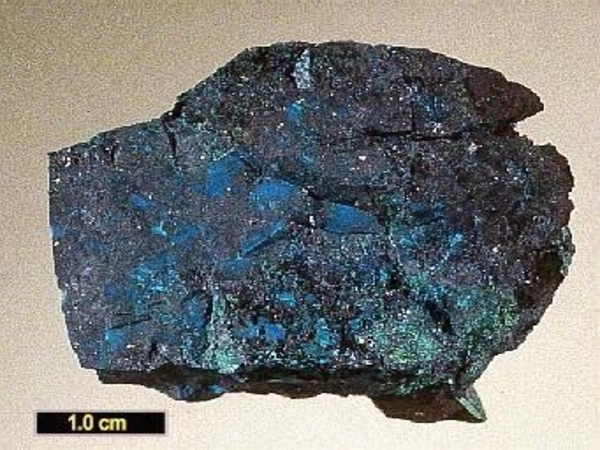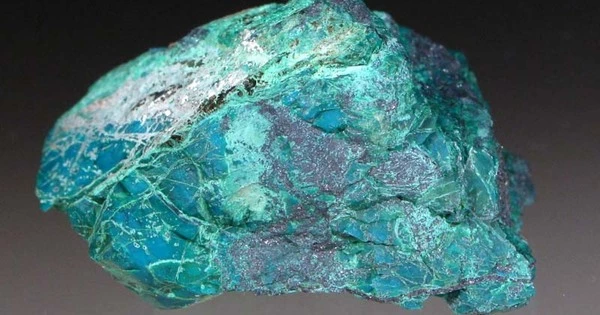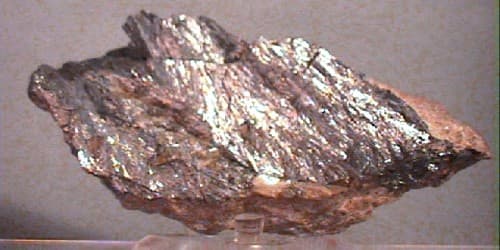Paramelaconite is a black copper(I,II) oxide mineral with the formula CuI2 CuII2O3 (or Cu4O3). It is a tetragonal mineral composed of cupric and cuprous oxides that forms black pyramidal crystals. It was discovered around 1890 in the Copper Queen Mine in Bisbee, Arizona. It was first described in 1892, and then again in 1941. It gets its name from the Greek word for “near” and the mineral melaconite, which is now known as tenorite.
General information
- Category: Oxide mineral
- Formula: CuI2 CuII2O3 (or Cu4O3)
- Crystal system: Tetragonal
- Crystal class: Ditetragonal dipyramidal (4/mmm)
- Color: Black to black with a slight purple tint; White with pinkish brown tint in reflected light

Properties
- Crystal habit: Occurs as striated prismatic crystals; massive
- Cleavage: None observed
- Fracture: Conchoidal
- Tenacity: Brittle
- Mohs scale hardness: 4.5
- Luster: Sub-adamantine, greasy, sub-metallic
- Streak: Brown-black
- Diaphaneity: Opaque
- Specific gravity: 6.04–6.11 (measured)
- Optical properties: Uniaxial
- Pleochroism: Weak
- Ultraviolet fluorescence: Not fluorescent
- Solubility: Soluble in HCl and HNO3
Description
Paramelaconite is black to black with a slight purple tint in color, and white with a pinkish brown tint in reflected light. The mineral occurs as a massive habit or as crystals up to 7.5 cm in size (3 in). When the mineral is dissolved in hydrochloric acid, it turns yellow; when dissolved in nitric acid, it turns blue; and when exposed to ammonium hydroxide, it turns slightly brown. When heated, paramelaconite degrades into tenorite and cuprite.
The first unequivocal synthesis of the mineral was achieved in the 1990s and published in 1996. The final product contained 35% Cu4O3, 27% Cu2O, and 38% CuO. The process consists of the leaching of copper or its oxides with concentrated aqueous ammonia in a Soxhlet extractor. The reaction forms a deep blue complex of cupric ammonium that is converted to a residue of black oxide in the apparatus.
History
Around 1890, Albert E. Foote visited the Copper Queen Mine and obtained two specimens of unknown minerals. He could only think of anatase, but he doubted that the minerals were any kind of titanium oxide. The specimens were sold to Clarence M. Bement for fifty dollars each and were studied by George Augustus Koenig with his permission. J. P. Morgan bought Bement’s collection, which included paramelaconite specimens, in 1900 and donated it to the American Museum of Natural History.
Synthesis
In 1986, the synthesis of microscopic paramelaconite was reported as a byproduct of CuO decomposition in an electron microscope. However, this method is difficult to scale up to produce large enough samples for research. CuO reduction and decomposition in vacuum, as well as controlled oxidation of Cu2O, failed to synthesize the mineral. Experiments conducted at the National Bureau of Standards with aqueous solutions heated to 250 °C yielded only Cu2O and CuO. Contrary to popular belief, oxidation of copper or its alloys does not result in the formation of paramelaconite.
Occurrence: A very rare secondary mineral in hydrothermal copper deposits.
Many specimens claiming to be paramelaconite are actually mixtures of cuprite and tenorite. In copper hydrothermal deposits, paramelaconite forms as a secondary mineral. It can be found in the presence of atacamite, chrysocolla, connellite, cuprite, dioptase, goethite, malachite, plancheite, and tenorite. The mineral has been discovered in Cyprus, the UK, and the US.
Association: Cuprite, tenorite, connellite, malachite, goethite (Bisbee, Arizona, USA); cuprite, tenorite, chrysocolla, malachite, plancheite, dioptase, atacamite (Algomah mine, Michigan, USA).
















